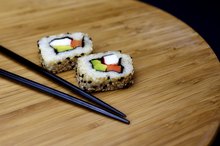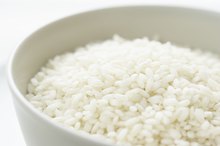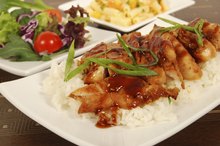Unmilled Vs. Milled Rice Facts
Rice is a versatile grain that is a major part of several ethnic cuisines. It provides complex carbohydrates with only 100 calories in a one-half cup serving, according to the U.S. Department of Agriculture. Rice comes in several sizes, colors and forms. One way to categorize rice is whether or not the grains have been subjected to milling. Milling is a process where the outer layers of the grains are removed, exposing the white kernels inside.
Manufacturing Differences
Unmilled rice has only the husk removed, according to the USA Rice Federation. A common term for this is brown rice, although black rice, purple rice and red rice are other available varieties of unmilled rice. Milled rice is commonly called white rice or polished rice. The husk, bran and possibly even the germ layers are removed to varying degrees in milled rice. Parboiled rice falls somewhere in between these two varieties. Pressure steaming the rice prior to milling produces parboiled rice.
- Unmilled rice has only the husk removed, according to the USA Rice Federation.
- A common term for this is brown rice, although black rice, purple rice and red rice are other available varieties of unmilled rice.
Nutritional Differences
Difference Between Fiberglass & Plaster Cast
Learn More
The milling process removes a considerable amount of B vitamins, vitamin E, minerals, fiber, essential fatty acids and some protein. Thus, milled rice is mainly a source of carbohydrates and protein. Unmilled rice is marketed as whole grain and is an excellent source of dietary fiber. Rice should be complemented with other foods to get sufficient quantities of high-quality protein, fat and other nutrients. The nutritional content of milled rice can be enhanced with added minerals and vitamins. This is called enrichment. Unmilled black and purple rice have more protein than brown or white rice.
- The milling process removes a considerable amount of B vitamins, vitamin E, minerals, fiber, essential fatty acids and some protein.
- The nutritional content of milled rice can be enhanced with added minerals and vitamins.
Cooking Differences
Brown rice or unpolished rice requires slightly longer cooking times than white or polished rice. Parboiled rice is less prone to overcooking and is used in commercial products such as canned soups and frozen foods. Brown rice might also need more water for cooking because it takes longer to cook. Both types of rice can be prepared in various ways, including steaming, pressure cooking, boiling and microwave cooking.
- Brown rice or unpolished rice requires slightly longer cooking times than white or polished rice.
- Both types of rice can be prepared in various ways, including steaming, pressure cooking, boiling and microwave cooking.
Flavors and Textures
Nutrition Information For Brown Rice Sushi
Learn More
Brown rice has a nutty flavor. White rice can be fragrant if it is one of the aromatic varieties such as basmati or jasmine. Long-grain rice tends to be firm, and the grains stay separate even after cooking. This is unlike the medium-grain and short-grain varieties, which are stickier. Long-grain rice also tends to be less moist. Parboiled rice is firm.
- Brown rice has a nutty flavor.
- Long-grain rice tends to be firm, and the grains stay separate even after cooking.
Shelf Life
In general, brown rice and other unmilled varieties contain more oil because they retain the bran and germ layers. This oil is susceptible to oxidation and degradation, which limits shelf life. Brown rice can last up to six months in the pantry when kept in a dry, airtight container. Its shelf life is increased when stored in the refrigerator. Milled rice or white rice stays fresh for much longer periods than unmilled varieties when stored under proper conditions, avoiding exposure to moisture and air.
- In general, brown rice and other unmilled varieties contain more oil because they retain the bran and germ layers.
- Brown rice can last up to six months in the pantry when kept in a dry, airtight container.
Related Articles
References
- Food and Agriculture Organization of the United Nations: Rice and Human Nutrition
- Rice, white, short-grain, enriched, cooked. FoodData Central. U.S. Department of Agriculture. Published April 1, 2019.
- Rice, brown, cooked. FoodData Central. U.S. Department of Agriculture. Published April 1, 2019.
- Roy P, Orikasa T, Okadome H, Nakamura N, Shiina T. Processing conditions, rice properties, health and environment. Int J Environ Res Public Health. 2011;8(6):1957-76. doi:10.3390/ijerph8061957
- Fung KY, Cosgrove L, Lockett T, Head R, Topping DL. A review of the potential mechanisms for the lowering of colorectal oncogenesis by butyrate. Br J Nutr. 2012;108(5):820-31. doi:10.1017/s0007114512001948
- Harris KA, Kris-Etherton PM. Effects of whole grains on coronary heart disease risk. Curr Atheroscler Rep. 2010;12(6):368-76. doi:10.1007/s11883-010-0136-1
- Cermak NM, van Loon LJ. The use of carbohydrates during exercise as an ergogenic aid. Sports Med. 2013;43(11):1139-55. doi:10.1007/s40279-013-0079-0
- Jeon YH, Oh SJ, Yang HJ, Lee SY, Pyun BY. Identification of major rice allergen and their clinical significance in children. Korean J Pediatr. 2011;54(10):414-21. doi:10.3345/kjp.2011.54.10.414
- Nowak-Węgrzyn A, Chehade M, Groetch ME, et al. International consensus guidelines for the diagnosis and management of food protein-induced enterocolitis syndrome: Executive summary-Workgroup Report of the Adverse Reactions to Foods Committee, American Academy of Allergy, Asthma & Immunology. J Allergy Clin Immunol. 2017;139(4):1111-1126.e4. doi:10.1016/j.jaci.2016.12.966
- Qian Y, Chen C, Zhang Q, Li Y, Chen Z, Li M. Concentrations of cadmium, lead, mercury and arsenic in Chinese market milled rice and associated population health risk. Food Control. 2010;21(12):1757-1763. doi:10.1016/j.foodcont.2010.08.005
- Havenaar R. Intestinal health functions of colonic microbial metabolites: a review. Benef Microbes. 2011;2(2):103-14. doi:10.3920/bm2011.0003
- Labensky SR, Hause AM, Martel P. On Cooking: a Textbook of Culinary Fundamentals. Boston: Pearson; 2015.
Writer Bio
Arie Kimbell is a dentist and a medical transcription editor. Based in the Dallas area, she specializes in health and fitness topics.









